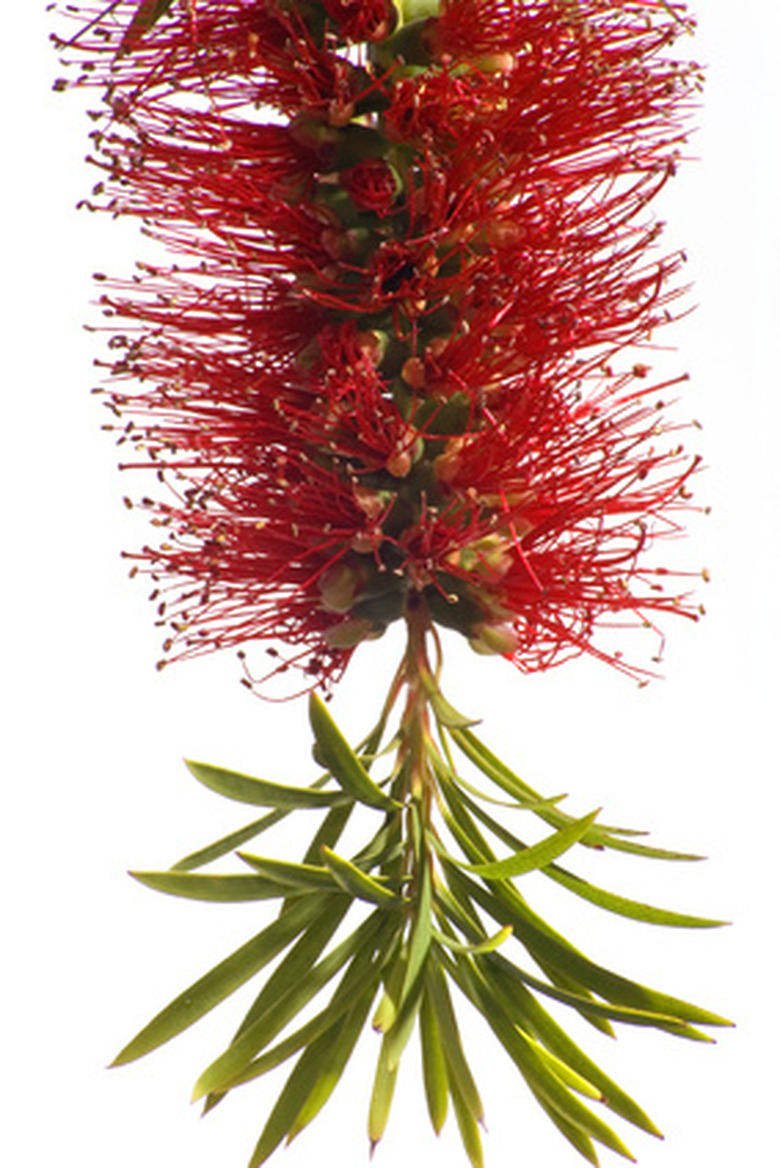How To Start Bottlebrush From Cuttings
The bottlebrush plant has an unusual bloom that really does look like a bottle brush. The spiky flower colors are found in red, mauve, pink, cream and green. Once a bottlebrush is established in the garden, take cuttings from it to produce new plants. These also make inexpensive gifts for friends, family or office co-workers, when planted in an attractive pot after roots have formed.
Step 1
Rub your garden clippers with alcohol, to disinfect them. Cut right above the joint of a limb of a bottlebrush plant with the clippers. The cutting should be at least 10 inches long. Cut at an angle, as you would cut flowers. Place the cut end in a container of water, immediately.
- The bottlebrush plant has an unusual bloom that really does look like a bottle brush.
- Once a bottlebrush is established in the garden, take cuttings from it to produce new plants.
Step 2
Create a mixture of equal parts peat moss and sand. These ingredients can be purchased from garden centers or nurseries. Fill a container with the mixture.
Step 3
Make an indentation in the peat moss mixture, about 5 inches deep, with a pencil or thin dowel.
Step 4
Dip the cut end of the bottle brush limb into rooting gel (found at nurseries or garden centers). The gel gives the limb the proper nutrients to start rooting.
Step 5
Place the bottle brush cutting into the hole made in the peat moss mixture. Use your fingers to work the mixture around the cutting, until it is secure.
- Create a mixture of equal parts peat moss and sand.
- Make an indentation in the peat moss mixture, about 5 inches deep, with a pencil or thin dowel.
Step 6
Water the peat moss mixture just to retain moistness. Check often, by digging into the material with your finger. Do not over water, as this could cause the formation of mold. The cutting should be ready for transplanting in approximately six weeks.
Propagate Bottlebrush Plants From Cuttings
The long hot days of summer invite the gardener to relax after the spring planting season, but if you want to propagate bottlebrush shrubs (Callistemon spp. ), summer is the time to start. Weeping bottlebrush, however, often roots a few weeks faster than crimson bottlebrush. Take cuttings in the summer for weeping bottlebrush plants and late summer for crimson bottlebrush. Use a pair of sharp hand-held pruning shears and cut at a 45-degree angle. Clip off any flowers at the top of the cutting. To avoid contaminating the tub, put a tablespoon or two in a bowl for each rooting project. Fill a container with the prepared rooting medium. Slip your index finger, or a dowel or pencil, into the center of the pot about 3 inches deep and then slip the bottom end of the bottlebrush cutting into the hole. Set bottlebrush cuttings in an area out of direct sunlight where the temperature is 70 to 75 degrees Fahrenheit. Water through the winter when the soil feels dry under your fingers.
- Water the peat moss mixture just to retain moistness.
- To avoid contaminating the tub, put a tablespoon or two in a bowl for each rooting project.
Things Needed
- Garden clippers
- Sand
- Peat moss
- Rooting gel
- Containers
- Pencil or dowel
Tip
A peat and perlite mixture can be used instead of sand and peat mixture, if you prefer.
References
- Australian National Botanic Gardens: Callistemon (Bottlebrushes)
- Burke's Backyard: Bottlebrush
- University of Arizona: Propagating Bouganvillea and Bottlebrush
- University of Florida IFAS Extension: Callistemon Viminalis: Weeping Bottlebrush
- University of Florida Environmental Horticulture: Callistemon viminalis
- University of Florida IFAS Extension: Red Bottlebrush
- University of Florida Environmental Horticulture: Callistemon Citrinis
- University of Nebraska-Lincoln Extension: Backyard Farmer: Propagation With Softwood, Semi-hardwood and Hardwood Cuttings
- University of California Agriculture & Natural Resources: General Information on Propagation by Stem Cuttings
- University of Florida Gardening in a Minute: Success With Cuttings
- University of Florida IFAS Extension: Disinfecting Pruning Tools
